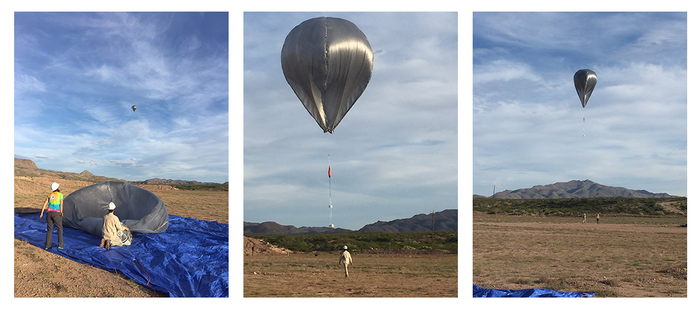CHICAGO, May 11, 2023 – Imagine if sending your science experiment 70,000 ft in the air just took painter’s plastic, tape, a dash of charcoal dust, and plenty of sunlight.

Credit: Darielle Dexheimer, Sandia National Laboratories.
CHICAGO, May 11, 2023 – Imagine if sending your science experiment 70,000 ft in the air just took painter’s plastic, tape, a dash of charcoal dust, and plenty of sunlight.
Daniel Bowman of Sandia National Laboratories will present his findings using solar-powered hot air balloons to eavesdrop on stratospheric sounds at the upcoming 184th Meeting of the Acoustical Society of America, running May 8-12 at the Chicago Marriott Downtown Magnificent Mile Hotel. His presentation will take place Thursday, May 11, at 2:50 p.m. Eastern U.S. in the Purdue/Wisconsin room at the Chicago Marriott Downtown Magnificent Mile Hotel.
The stratosphere is a relatively calm layer of Earth’s atmosphere. Rarely disturbed by planes or turbulence, microphones in the stratosphere pick up a variety of sounds unheard anywhere else. This includes natural sounds from colliding ocean waves and thunder, human-created sounds like wind turbines or explosions, and even sounds with unknown origins.
To reach the stratosphere, Bowman and his collaborators build balloons that span 6 to 7 meters across. Despite their large size and data collection capability, the balloons are relatively simple.
“Our balloons are basically giant plastic bags with some charcoal dust on the inside to make them dark. We build them using painter’s plastic from the hardware store, shipping tape, and charcoal powder from pyrotechnic supply stores. When the sun shines on the dark balloons, the air inside heats up and becomes buoyant. This passive solar power is enough to bring the balloons from the surface to over 20 km (66,000 ft) in the sky,” said Bowman. “Each balloon only needs about $50 worth of materials and can be built in a basketball court.”
The researchers collect data and detect low-frequency sound with microbarometers, which were originally designed to monitor volcanoes. After releasing the balloons, they track their routes using GPS – a necessary task since the balloons sometimes sail for hundreds of miles and land in hard-to-reach places. But, because the balloons are inexpensive and easy to construct and launch, they can release a lot of balloons and collect more data.
Along with the expected human and environmental sounds, Bowman and his team detected something they are not able to identify.
“[In the stratosphere,] there are mysterious infrasound signals that occur a few times per hour on some flights, but the source of these is completely unknown,” said Bowman.
Solar-powered balloons could also help explore other planets, such as observing Venus’ seismic and volcanic activity through its thick atmosphere.
###
———————– MORE MEETING INFORMATION ———————–
Main meeting website: https://acousticalsociety.org/asa-meetings/
Technical program: https://eppro02.ativ.me/web/planner.php?id=ASASPRING23&proof=true
ASA PRESS ROOM
In the coming weeks, ASA’s Press Room will be updated with newsworthy stories and the press conference schedule at https://acoustics.org/asa-press-room/.
LAY LANGUAGE PAPERS
ASA will also share dozens of lay language papers about topics covered at the conference. Lay language papers are summaries (300-500 words) of presentations written by scientists for a general audience. They will be accompanied by photos, audio, and video. Learn more at https://acoustics.org/lay-language-papers/.
PRESS REGISTRATION
ASA will grant free registration to credentialed and professional freelance journalists. If you are a reporter and would like to attend the meeting or virtual press conferences, contact AIP Media Services at [email protected]. For urgent requests, AIP staff can also help with setting up interviews and obtaining images, sound clips, or background information.
ABOUT THE ACOUSTICAL SOCIETY OF AMERICA
The Acoustical Society of America (ASA) is the premier international scientific society in acoustics devoted to the science and technology of sound. Its 7,000 members worldwide represent a broad spectrum of the study of acoustics. ASA publications include The Journal of the Acoustical Society of America (the world’s leading journal on acoustics), JASA Express Letters, Proceedings of Meetings on Acoustics, Acoustics Today magazine, books, and standards on acoustics. The society also holds two major scientific meetings each year. See https://acousticalsociety.org/.
###




